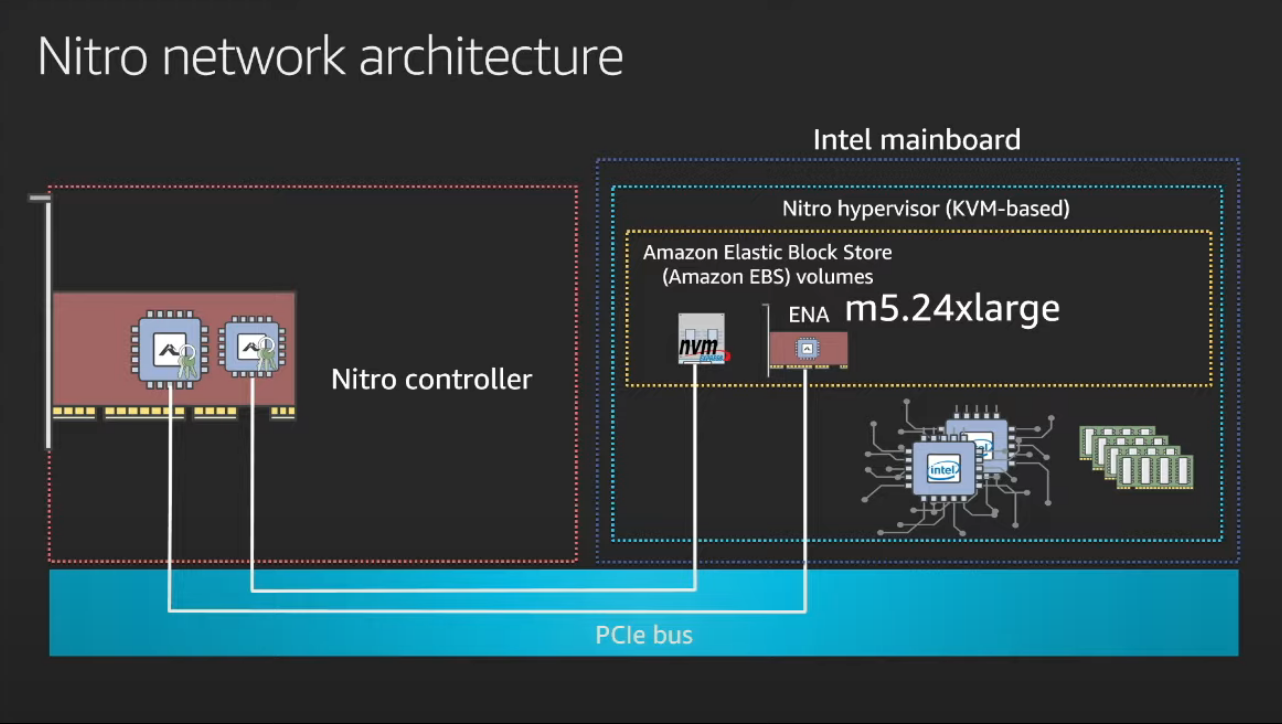AWS global network infrastructure (reInvent 2019)
- Network Aspects
- Nitro Network Architecture
- Building a scalable data center
- Availability Zones
- Transit Centers
- Physical Network Encryption
- AWS global network backbone
- Inside an Edge POP
- Summary
Network Aspects
- Security
- Availability
- Scalability
- Performance
- Global Reach
Nitro Network Architecture
- Nitro controller offloads in hardware lot of network features
- ACL, Security Groups, VPC Peering, etc..
- Gives consistent network performance
- VPC encryption - hardware accelerated encryption

Building a scalable data center
- Networking building blocks
- Make it easy to scale in right-sized segments
- Strong isolation boundaries
- Large amounts of network capacity
- Networking technology
- Routes
- Single-chip routers
- Constrained failure domain
- Fixed port types
- Many devices to manage
- Simpler forwarding architecture
- Single-chip routers
- Connectivity
- Host Rack Networking
- Partition placement groups
- Ensures that all of instances in a partition group do not share any of underlying hardware with a resource in another partition group
- Spread placement groups
- Guarantee that each instance on the placement group is placed on distinct rack, with each rack having its own network and power source
- Partition placement groups
- Host Rack Networking
- Control plane
- Using Single-chip-based platforms over large chassis-based platforms
- Routes
Network Pattern
- Core cell
- Provides external network connectivity
- Spine cell
- Interconnects placement groups
- Access cell
- Provides connectivity for underlying host rack based on the require number of uplinks
- Host rack
Availability Zones
- Failure isolation from other AZs
- Directly connects to other AZs
- One or more data centers
- Low-latency & close proximity
- Scalability
Transit Centers
- Provide internet and inter-region (backbone) connectivity
- All AZs are connected redundantly
- Located in facilities with dense internet connection

Physical Network Encryption
- Any link outside of AWS physical control, including between AWS data centers, and across AWS backbone is protected
- All traffic between AWS Regions (except China) is carried on the AWS backbone
- Most links protected with MACSEC or optical encryption using AES-256
- Small number of short-distance links use laser monitoring
AWS global network backbone
- AWS Direct Connect
- Internet Connectivity
- AWS Global Accelerator
- Region to Region communication
- AWS CloudFront to AWS services
Benefits of having global backbone
- Security
- Traffic traverses AWS infrastructure rather than the internet
- Availability
- Controlling scaling and redundancy
- Traffic operates over Amazon-controlled infrastructure
- Reliable Performance
- Controlling specific paths customer traffic traverses
- Connecting close to customers
- Avoid internet hot spots or sub-optimal external connectivity
Building a global backbone network
- Latency Matters
- Optimal in normalized situations
- Minimize additional latency during path failures
- 100G the new normal for backbone links
- Similar design patterns and operations to the data centers
- Extreme auditing of fiber paths
- End-to-end latency
- Path hazards
- Repair expectations
- Path diversity
- Understanding shared risk link groups (SRLGs)
- Capacity/Scale
- Underlying optical transport capabilities
Inside an Edge POP
- Multiple AWS Services
- AWS Direct Connect
- Low-latency access into AWS
- Access to all AWS regions
- Multiple customer-facing edge routes for redundancy
- Multiple Direct Connect locations for redundancy
- Amazon CloudFront & Amazon Route53
- At the Amazon global network perimeter
- Low-latency to external networks
- Origin fetches traverse the AWS network backbone
- IPv4 and IPv6 DNS anycast services
- AWS Shield
- Traffic scrubbing platforms to protect customers automatically
- Stopped at the internet edge before traffic reaches the backbone
- AWS Global Accelerator
- AWS Direct Connect
- AWS global network access
- Optimal interconnection with external networks
- AWS Region transit centers
- External internet connectivity
Summary
- Strong isolation from failures
- Extensive network monitoring and auto-remediation systems
- Large amounts of redundancy and over-provisioning
- Easily scalable at every layer
- Custom hardware and end-to-end control